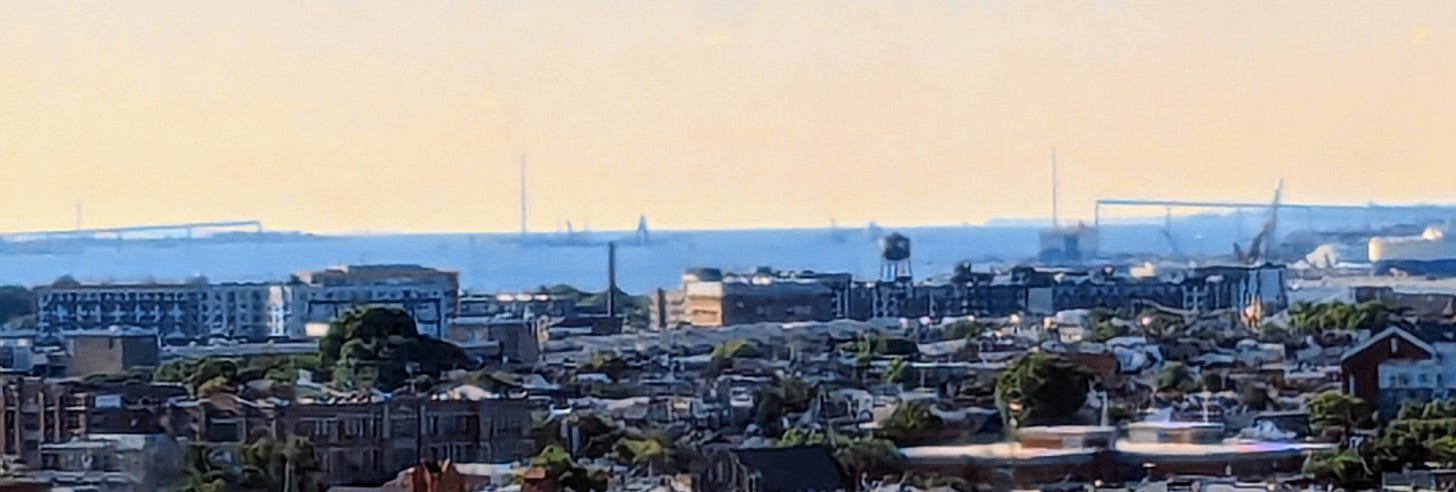Recently, I was in Baltimore, Maryland for a conference. From my hotel window, I could see the Inner Harbor leading out to the Chesapeake Bay via the Patapsco River. In the distance, as pictured below, I could just make out the two remaining ends of the Francis Scott Key Bridge, the middle spans of which collapsed on March 26, 2024 when it was struck by a container ship.
Bridges are a form of connection over a chasm or other obstacle. They provide safe passage over the obstacle without blocking passage underneath it. Many of the bridges we know and use today were built over fifty years ago, part of the great interstate highway system construction project that began in the 1950s and continued through the 1960s and 1970s. The Francis Scott Key Bridge in Baltimore opened in 1977. These bridges (and highways and tunnels) were constructed so long ago, that many of us do not remember before their existence. It is as if they have always existed and these rivers and waterways have always had spans connecting their banks. But that’s not true. Someone had to decide to that a bridge was needed. An engineer had to design the bridge. And construction workers had to actually build the bridge. Knowledge, choice, and skill all played a role in the bridges coming to be.
On an episode of the final season of “Star Trek: Discovery,” Captain Burnham, who is the first Black female Captain to star in a Star Trek series, says, “Connection is a choice, not a skill.” The quote provided quite a lot of food for thought, including spawning this series on connections. Ultimately, I landed on the opinion that connection is both choice and skill. You have to choose to connect; and you have to know how to connect.
Unfortunately, when the planners and engineers created the U.S. interstate highway system, while they created many connections among disparate places, they also caused disconnection. The creation of these highways had a devastating impact on people of color and low-income communities. I saw this effect firsthand when I went on a Pilgrimage of Pain and Hope in Durham, NC some fifteen years ago. The “Durham Freeway,” or NC-147, cut right through neighborhoods, disconnecting previously-connected streets and neighbors. It is estimated that over 4,000 families and some 500 businesses were displaced. Durham was previously the home of Black Wall Street; the urban renewal project of the 1960s, which connected and improved some parts of the city, disconnected other parts.
It’s an interesting juxtaposition to consider the two: a bridge over a river, used by tens of thousands of commuters each day and connecting two ends of a beltway to encircle the city; and a highway whose connection directly through a city benefited some but destroyed the livelihoods of those who already lived there. It seems like not enough skill, and certainly not enough care, was taken in Durham. A choice was made, and not everyone affected was taken into consideration.
Finally, at this conference in Baltimore, a prayer was offered for those who lost their lives in the bridge collapse, as well as those whose lives are affected by its loss. Moreover, the speaker stated that we are “called to make new roads and build new bridges so that everyone arrives safely at shore.” These are new connections, requiring both skill and choice and care, so that all may have safe passage to their destination without trampling over others on the way there. These are connections that do not cause disconnection, but are a mutual building up. This Juneteenth, may we create bridges and connections that are truly life-giving for all.




